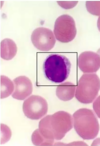An Overview of Immunology Flashcards
What is an antigen?
Anything the immune system responds to
Antigens are usually …
protein
Antigens are not necessarily ‘…’
‘bad’
The main role of the immune system is to protect from …
infection
What is an antigen receptor?
Recognises the antigen -> fundamental basis of immunity, basis of division into innate and adaptive
The innate immune system fundamentally recognizes antigens using ….
Germline-encoded pattern-recognition receptors
The adaptive immune system is activated in the presence of pathogens - … cells and … cells recognise antigens through …-specific … and … cell receptors
The adaptive immune system is activated in the presence of pathogens - T cells and B cells recognise antigens through antigen-specific T and B cell receptors
… mechanisms are an action to respond to the antigen (innate and adaptive have a lot of shared mechanisms - distinction is in the way they recognise the antigen rather than what happens next)
effector mechanisms
The cells of the immune system originate in the … …
The cells of the immune system originate in the bone marrow
Pluripotent hematopoietic stem cells thus differentiate into bone marrow as … or … stem cells.
Pluripotent hematopoietic stem cells thus differentiate into bone marrow as myeloid or lymphoid stem cells.

Pluripotent hematopoietic stem cells thus differentiate into bone marrow as lymphoid or myeloid stem cells (common lymphoid progenitor or common myeloid progenitor). These then give rise to the two lineages of immunological cell. We have lymphocyte lineage (… cells) and myeloid lineage (cells such as …)
Pluripotent hematopoietic stem cells thus differentiate into bone marrow as lymphoid or myeloid stem cells (common lymphoid progenitor or common myeloid progenitor). These then give rise to the two lineages of immunological cell. We have lymphocyte lineage (T,B, NK cells) and myeloid lineage (cells such as neutrophils, eosinphil, basophil, monocyte, mast cell)

Pluripotent hematopoietic stem cells thus differentiate into bone marrow as … or … stem cells.
Pluripotent hematopoietic stem cells thus differentiate into bone marrow as myeloid or lymphoid stem cells.

Pluripotent hematopoietic stem cells thus differentiate into bone marrow as lymphoid or myeloid stem cells (common lymphoid progenitor or common myeloid progenitor). These then give rise to the two lineages of immunological cell. We have lymphocyte lineage (… cells) and myeloid lineage (cells such as …)
Pluripotent hematopoietic stem cells thus differentiate into bone marrow as lymphoid or myeloid stem cells (common lymphoid progenitor or common myeloid progenitor). These then give rise to the two lineages of immunological cell. We have lymphocyte lineage (T,B, NK cells) and myeloid lineage (cells such as neutrophils, eosinphil, basophil, monocyte, mast cell)

What is the function of a neutrophil?

Phagocytosis
What cell is this? (White blood cell)
Neutrophil
What cell is this? (White blood cell)
Neutrophil
What is the function of an eosinophil? (is not fully understood - may be important in what infections?)

? Helminth (parasitic) infection, allergies also
What cell is this? (White blood cell)

Eosinophil
What cell is this? (White blood cell)

Monocyte (Circulating) Called Macrophage (in the tissue)
What is the function of a monocyte? (called macrophage in tissue)

Phagocytosis, Antigen presentation
What is the function of a dendritic cell?

Antigen presentation
What cell is this?

Dendritic cell
What cell is this? (White blood cell)

Basophil - tissue-resident counterpart = mast cell
What is the function of a basophil? (tissue-resident counterpart = mast cell)

?Helminth (parasitic infection) also in allergy - release histamine
Lymphoid lineage
- Similar size to …
- Little … with few …
- … cells - make antibody, antigen presentation
- … cells - … (help other components of immunity) … (kill infected cells)
- T and B cells = … immunity
- NK cells are actually … lymphocytes. Direct lysis of infected cells and antibody-dependent cellular cytotoxicity

- Similar size to RBC
- Little cytoplasm with few granules
- B cells - make antibody, antigen presentation
- T cells - CD4 (help other components of immunity) CD8 (kill infected cells)
- T and B cells = adaptive immunity
- NK cells are actually innate lymphocytes. Direct lysis of infected cells and antibody-dependent cellular cytotoxicity
Lymphoid lineage
- Similar size to …
- Little … with few …
- … cells - make antibody, antigen presentation
- … cells - … (help other components of immunity) … (kill infected cells)
- T and B cells = … immunity
- NK cells are actually … lymphocytes. Direct lysis of infected cells and antibody-dependent cellular cytotoxicity

- Similar size to RBC
- Little cytoplasm with few granules
- B cells - make antibody, antigen presentation
- T cells - CD4 (help other components of immunity) CD8 (kill infected cells)
- T and B cells = adaptive immunity
- NK cells are actually innate lymphocytes. Direct lysis of infected cells and antibody-dependent cellular cytotoxicity
Only T cells do not mature in the bone marrow, they mature in the …
thymus
Communication - Intercellular Signalling
- What types are there?
- Endocrine - hormones released to act on a target cell
- Paracrine - nearby cells
- Autocrine - acts on own cell
- Juxtacrine - direct contact with another cell

Communication - Intercellular Signalling
- What types are there?
- Endocrine - hormones released to act on a target cell
- Paracrine - nearby cells
- Autocrine - acts on own cell
- Juxtacrine - direct contact with another cell

Often, cells that are near one another communicate through the release of chemical messengers (ligands that can diffuse through the space between the cells). This type of signaling, in which cells communicate over relatively short distances, is known as … signaling.
Often, cells that are near one another communicate through the release of chemical messengers (ligands that can diffuse through the space between the cells). This type of signaling, in which cells communicate over relatively short distances, is known as paracrine signaling.
In autocrine signalling, the cell targets…
itself
Communication: Cytokines and Chemokines
- Cytokines are small proteins released by cells that have an effect on another cell - (important for communication between cells of the immune system and between immune system cells and other cells and tissues) - Known as … then a number referring to order of discovery, but some are named differently eg TGF-B, IFN,g, TNF-a
- Chemokines are similarly defined, but - different structure, receptors and nomenclature and main role is temporal and spatial … of cells and tissues
- Cytokines are small proteins released by cells that have an effect on another cell - (important for communication between cells of the immune system and between immune system cells and other cells and tissues) - Known as Interleukin then a number referring to order of discovery, but some are named differently eg TGF-B, IFN,g, TNF-a
- Chemokines are similarly defined, but - different structure, receptors and nomenclature and main role is temporal and spatial organisation of cells and tissues
Communication: Cytokines and Chemokines
- Cytokines are small … released by cells that have an effect on … - (important for communication between cells of the immune system and between immune system cells and other cells and tissues) - Known as Interleukin then a number referring to order of discovery, but some are named differently eg TGF-B, IFN,g, TNF-a
- Chemokines are similarly defined, but - different structure, receptors and nomenclature and main role is … and … organisation of cells and tissues
- Cytokines are small proteins released by cells that have an effect on another cell - (important for communication between cells of the immune system and between immune system cells and other cells and tissues) - Known as Interleukin then a number referring to order of discovery, but some are named differently eg TGF-B, IFN,g, TNF-a
- Chemokines are similarly defined, but - different structure, receptors and nomenclature and main role is temporal and spatial organisation of cells and tissues


































